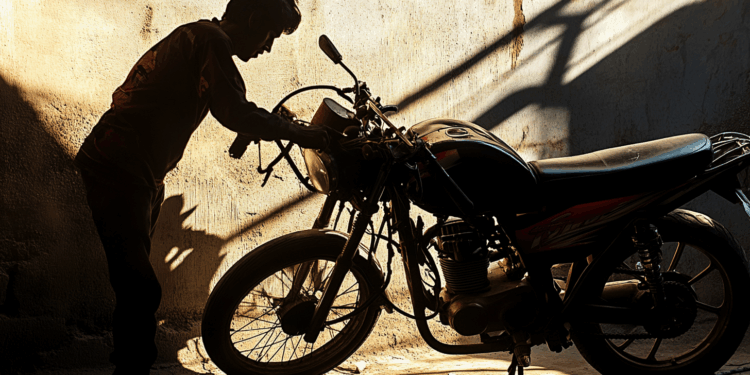In a grid-down scenario, every drop of fuel matters. If your truck runs dry or you’re trying to power a generator, being able to siphon gas, especially from a motorcycle, might mean the difference between survival and sitting dead in the water. This is why it is important to learn how to siphon gas from a motorcycle.
But here’s the thing: siphoning gas from a motorcycle isn’t as simple as sticking a hose in the tank and sucking. Many modern bikes are designed to prevent this, and without the right know-how, you could waste time, spill precious fuel, or damage the tank. In many cases, it can be more difficult than draining a car fuel tank.
Let’s walk through why it’s sometimes tricky, which motorcycles are easier to work with, and exactly how to siphon fuel the right way.
Why Siphoning from a Motorcycle Can Be Difficult
Unlike older vehicles with gravity-fed fuel systems and simple filler necks, many modern motorcycles come with anti-siphon valves, fuel injection systems, or internal fuel pumps. These features are designed to improve performance or reduce theft, but they make emergency siphoning a challenge.
You might run into trouble if:
- The fuel tank has a narrow filler neck or internal baffles
- The bike uses EFI (Electronic Fuel Injection) with no inline fuel hose access
- There’s a locking gas cap or an internal anti-siphon screen
- The tank design makes it hard to reach the lowest point where gas pools
In short: the more modern and high-end the bike, the harder it usually is to siphon.
What Motorcycle Models Are Easier to Siphon From?
Generally, older carbureted motorcycles are your best bet. These bikes often have simple tanks with petcocks (fuel shut-off valves), gravity-fed fuel lines, and no anti-siphon features.
Some easier models include:
- Honda CB series (pre-2000)
- Yamaha XS650
- Kawasaki KLR650 (older models)
- Harley-Davidson carbureted models (pre-2006)
- Dirt bikes and dual sports with visible external fuel lines
When in doubt, look for:
- A carburetor instead of fuel injection
- An external, transparent fuel hose
- A manual petcock at the bottom of the tank
These are all green flags that siphoning will be doable without high risk of damage or time-consuming disassembly.
Tools and Materials You’ll Need
Even if you’re siphoning from a simple system, you’ll need the right tools:
- Clear plastic tubing (about 1/4″ to 3/8″ diameter, 2-3 feet long)
- Small fuel-safe container (metal or thick plastic)
- Screwdriver (flathead for loosening hose clamps if needed)
- Optional: bulb siphon pump (if you want to avoid mouth siphoning)
- Rag or towel (to wipe up spills or hold open stiff gas caps)
And most importantly: a steady hand and patience.
How to Siphon Gas from a Motorcycle: Step-by-Step
For a visual representation, watch the clip above!
There are two main ways to siphon gas from a motorcycle: through the filler neck, or directly from the fuel line.
Method 1: Through the Filler Neck (If No Anti-Siphon Screen)
- Ensure the bike is stable. Put it on the center stand if available. Avoid working near open flames or sparks.
- Remove the gas cap. If it’s locked and you don’t have a key, you’ll need to drill it or pry it open (only in a true emergency).
- Insert your siphon tube. Slowly feed it into the tank, aiming downward and toward the far side of the tank. You may need to twist slightly to work around baffles.
- Start the siphon. Use a bulb pump or the manual method:
- Create suction by sucking gently (avoid swallowing fumes, use your tongue as a stop valve).
- As fuel nears the end of the tube, lower it quickly into your container.
- Watch the flow. Gravity should keep it going once it starts, as long as the fuel source is higher than the receiving container.
- Remove the tube when done. Cap the tank, clean up spills, and store any fuel safely.
Method 2: From the Fuel Line (More Reliable for Carbureted Bikes)
- Locate the fuel line. Trace it from the tank to the carburetor. On many bikes, it’s visible and held on with a clamp.
- Turn off the petcock. (If there is one.) This prevents fuel from flowing while you disconnect the line.
- Loosen the hose clamp. Use a screwdriver or your fingers if it’s a simple tension clamp.
- Attach your tubing. Slip your siphon tube onto the tank’s fuel outlet or the end of the fuel line.
- Turn on the petcock. Fuel will begin to flow through the siphon into your container.
- Control the flow. Some petcocks have ON/RESERVE/PRI settings. PRI (prime) lets fuel flow freely without vacuum from the engine.
- Clamp and reconnect. When done, replace the original fuel line and tighten the clamp securely.
A Few Tips to Keep in Mind
- Always work in a ventilated area. Gas fumes are highly flammable and toxic.
- Use clear tubing to see the fuel flow.
- Never siphon by mouth if you suspect ethanol-blended gas. It’s toxic!
- Avoid this method on fuel-injected bikes unless you know what you’re doing because damaging a high-pressure fuel system is not worth it.
Final Thoughts
Knowing how to siphon gas from a motorcycle is one of those survival skills that’s easy to overlook, until you need it. Whether you’re bugging out, bartering for fuel, or simply keeping your gear running, motorcycles are often overlooked but valuable fuel sources, especially when cars are dry or siphon-proof.
Just remember: older bikes are your friend, and knowing how to work around modern systems takes a bit of know-how. Practice before you need to rely on this trick, and you’ll be one step ahead when the system goes down.
You may also like:
 6 Mistakes You Are Probably Making When Buying Your Guns
6 Mistakes You Are Probably Making When Buying Your Guns
Arizona Farmer Accidentally Discovers Trick to Turn Air into Water (Video)
How to Hot-Wire a Car When The SHTF (with pictures)





















